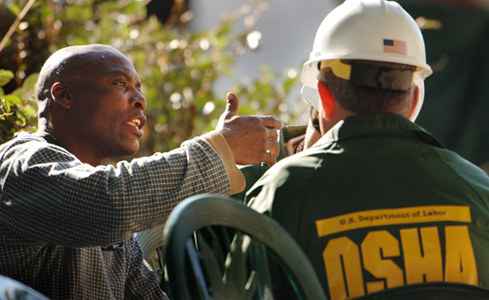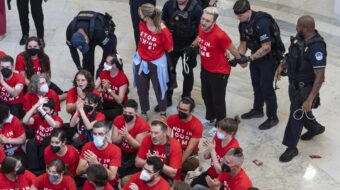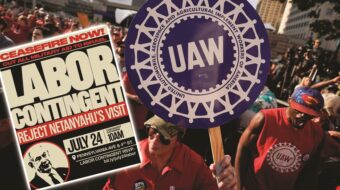
WASHINGTON (PAI) — Top Occupational Safety and Health Administration (OSHA) official Jordan Barab found himself walking a fine line recently in discussing firms’ “voluntary protection” safety and health efforts.
On the one hand, Barab, the agency’s deputy administrator and a former top union safety and health official, had to deal with ruling House Republicans who demand OSHA emphasize its Voluntary Protection Program (VPP) – an oft-criticized effort that lets firms monitor themselves while escaping frequent agency inspections.
On the other hand, Barab had to respond to criticisms from both unions and the non-partisan Government Accountability Office (GAO). Both say OSHA doesn’t have the staff, data or resources to monitor VPP firms’ performance – even when workers at VPP firms die on the job.
As a result, in testifying to a highly partisan GOP-run House Education and the Workforce subcommittee, Barab found himself both saying VPP is effective while admitting it has holes – holes that can be fixed by hiring more people, requiring more information from the VPP participants and conducting more frequent inspections.
The VPP issue is important. OSHA is short-staffed. “Voluntary programs still are part of the OSHA program but are viewed as supplemental to, not a replacement for, enforcement,” the AFL-CIO’s most recent Death on the Job report says. OSHA has 1,733 VPP sites nationwide. It also has just over 2,000 staffers, including inspectors.
Barab told lawmakers that at those sites, deaths and injuries declined. “The recorded number of all nonfatal job injuries and illnesses” per 100 workers at VPP non-construction sites is 45% below comparable federal figures for all firms in those sectors, he testified. For construction participants, the difference is 60%, he added.
And at VPP participants, the rate of injuries and illnesses that force workers to miss time, or have work restrictions or job transfers, is 56% below recorded rates for both construction and non-construction firms, he added.
“Fewer injuries and illnesses mean greater profits for employers as workers’ compensation premiums and other costs, such as downtime, are reduced. Industries gain from VPP because VPP participants set an example for other companies. For its part, OSHA gains a corps of ambassadors who are enthusiastic about the message of safety and health management and who are eager to share their success stories with others,” Barab said.
That’s the good news. Then there was the bad news. One bad news item is money, or lack of it, he warned the lawmakers.
“There are serious issues with VPP we are striving to address. First, in these challenging economic times, OSHA must struggle to meet competing priorities and balance our resources,” he stated. “Make no mistake: The Department of Labor is committed to VPP, as well as OSHA’s other cooperative programs, but like every other federal agency, we need to make some very hard decisions about how to allocate our limited resources where we will get the most worker protection ‘bang for our buck.’
“Our challenge is to maintain an active, quality VPP while providing assistance to small businesses, help for vulnerable workers, support to enable workers to exercise their rights under the law, and an active enforcement program that focuses on the worst offenders-the companies that don’t get the message, continue to ignore the law, and needlessly put workers’ lives in jeopardy.”
But the second serious issue is VPP’s credibility. The key to the program is that firms must file, and have OSHA review and approve in advance, credible safety and health programs, in order to be – as Barab admitted and as the GOP majority and its business backers lobby for – free from regular OSHA enforcement.
But the VPP program grew so much during the GOP Bush years, when OSHA enforcement came to a dead halt, that VPP has a huge backlog of re-inspections to undertake in firms whose initial VPP contracts have expired, he admitted.
Meanwhile, the independent Center for Public Integrity reported 80 workers died on the job at 47 VPP participants since 2001, yet 65% of those firms are still in VPP.
“Even when workers die and inspectors find safety violations, ‘model workplaces’ often face minimal consequences and retain the special designation,” the center said. As VPP participation tripled in the last decade, OSHA “cut the number of staffers overseeing it and weakened requirements for membership, raising questions about how well” VPP “supplements the efforts of inspectors in safeguarding workers.
“Little widespread evidence exists that the 29-year-old program works. Despite calls by the GAO and others for OSHA to complete a comprehensive evaluation of the program’s effectiveness, none has occurred.”
Barab cited the center’s report and the GAO findings, in telling the Republicans VPP must supplement, not replace, job safety enforcement, as the Republicans and their business backers demand.
“VPP is an integral part of the toolbox Congress provided to OSHA to accomplish our mission. We must have strong enforcement for employers who simply will not adequately protect their workers’ safety and health, as well as provide needed assistance to small employers and vulnerable workers. But we must also continue to recognize and reward employers who go beyond OSHA’s requirements in protecting their employees,” he concluded.
Photo: A worker talks with OSHA investigators across the scene from a collapsed parking garage. The structure collapsed during a concrete pour. Bob Self /The Florida Times-Union/AP












Comments